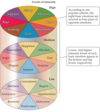11/23 Flashcards
(57 cards)
Emotion
A subjective mental state that is usually accompanied by distinctive cognition, behaviors, and physiological changes.
Subjective and very important part of our lives.
Brian self-stimulation
The process in which animals will work to provide electrical stimulation to particular brain sites, presumably because the experience is very rewarding.

Medial Forebrain Bundle
A collection of axons traveling in the midline region of the forebrain.

Nucleus Accumbens
A region of the forebrain that receives dopaminergic innervation from the ventral tegmental area, often associated with reward and pleasurable sensations.
Decorticate Rage
Also called sham rage. Sudden intense rage characterized by actions (such as snarling and biting in dogs) that lack clear direction.
Lymbic System
Nuclei implicated in emotion
Cingulate Cortex, Basal forebrain nuclei, Mammillary Body, Amygdala, Hippocampus

Klüver-Bucy syndrome
A condition, brought about by bilateral amygdala damage, that is characterized by dramatic emotional changes including reduction in fear and anxiety.
- compleetly dosile, loss of fear, removal of temporal lobe (contains amigdala) or stroke damage
Fear Conditioning
A form of classical conditioning in which a previously neutral stimulus is repeatedly paired with an unpleasant stimulus, like foot shock, until the previously neutral stimulus alone elicits the responses seen in fear.
Important in PTSD
Emotion is a
private, subjective feeling that we may have without anyone else being aware of it
Emotional is
used to describe many behaviors that people show
during strong emotion
we often experience physiological changes
The relationship between emotion and physiological arousal is
more subtle than common sence sujects

The James-Lange theory
the emotions we experience are caused by the bodily changes.
we experience fear because we perceive the activity that dangerous conditions trigger in our body
attempts to link specific emotions to specific bodily responses.

__ tend to be accompanied by sympathetic activation
Fear, surprise, and anger
__ tend to be accompanied by parasympathetic activation
joy and sadness
Cannon-Bard theory
it is the brain’s job to decide which particular emotion is an appropriate response to the stimuli
the cerebral cortex simultaneously decides on the appropriate emotional experience and activates the autonomic nervous system to appropriately prepare the body

Main take away from SM paper
CO2 might engage interoceptive afferent sensory pathways that project to the brainstem, diencephalon and insular cortex.
Air Hunger
the conscious appreciation of an uncomfortable urge to breathe
Animal models for fear
Are difficult to use
Eight primary human emotions
Fear, Anger, Suprise, Expectation, Sadness, Happiness, Disgust, Affection

Sadness (Name Pair)
Happiness
Disgust (Name Pair)
Affection
Anger (Name Pair)
Fear
Expectation (Name Pair)
Suprise








